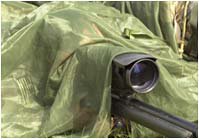SPEED OF LIGHT: Gunfire Detection

Associated Press
WASHINGTON - A sniper fires on American troops in Iraq. In the milliseconds before the bullet hits - in fact, before the shot is even heard - a computer screen reveals the gun's model and exact location.
That's the kind of intelligence that can save soldiers' lives. The Army is currently testing the technology in combat.
The devices are made by Radiance Technologies, a small Alabama company, and differ in their approach to gunfire detection from systems already deployed in Iraq that rely on acoustics.
Radiance's invention, WeaponWatch, is powered by infrared sensors that detect missiles or gunfire at the speed of light.
"Obviously when the first shot is fired, you can't do anything about it," said George Clark, president of the company founded in 1999. "But what it does do is it allows you to not have a second fired."
WeaponWatch is a major reason that Radiance, which had only three employees six years ago, now has 275. Over that period, it's been one of the 500 fastest-growing small businesses in the United States.
Nobody seems to dispute that WeaponWatch is the fastest such system on the market, but the challenge for company executives was persuading the Pentagon that those few extra nanoseconds provide any practical advantage over the existing sonar versions, which have a wider field of vision.
After all, human reflexes are far more sluggish than either light or sound.
Cambridge, Mass.-based BBN Technologies makes one of the leading acoustic devices. Its system detects enemy gunfire with an array of microphones and is known as Boomerang. Funded by the Defense Advanced Research Projects Agency, it was deployed in Iraq last year.
More than 100 of its units have been built, though the company is unsure how many are being used by soldiers.
Stephen Milligan, BBN's technology director, says a likely advantage of sonar is that it produces fewer false alarms than infrared.
"There are many ways to create an infrared flash," Milligan said. "I would guess it is ultimately possible to spook it."
But Charles Kimzey, who manages the Pentagon's research program that includes weapon detection systems, says that while both acoustic and infrared each have their advantages, early tests indicate Radiance's device is superior.
"The feedback we've gotten has been quite favorable," Kimzey said.
For security reasons, Pentagon officials refuse to disclose which U.S. military units have used WeaponWatch and where.
Walt Smith, a technology director at Radiance who traveled with the system to Iraq during its March 2004 launch, said soldiers like it because of its precision.
"A person who has a rugged tablet personal computer can see an image," Smith said. "Someone on the second floor, third window from the right, shot from that location."
The system was tested on top of a building where there was a high concentration of insurgent gunfire. Within a few days, American troops were able to use WeaponWatch to return fire more rapidly, Smith said, resulting in a noticeable drop in enemy attacks.
Interesting technology. Here's the rest of the story.
A tip of the hat to: Military.com

































<< Home